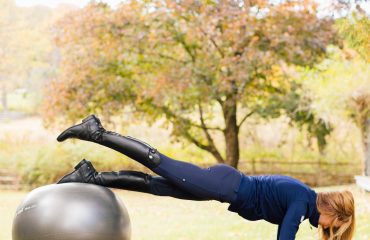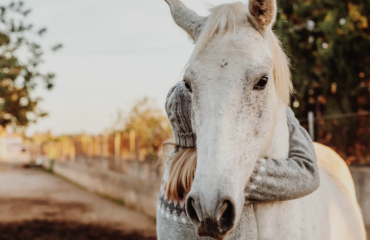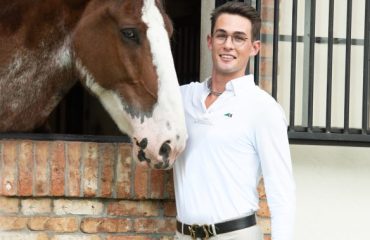
Steffen Peters, a three-time Olympic veteran, and Ravel at the London 2012 Olympic Games. Steffen will ride Legolas 92 in the 2016 Olympics in Rio and is hoping the 2016 Olympic dressage team will dance their way to the podium.
Photo by Kim MacMillan/MacMillan Photography
By Lauren R. Giannini
Beautiful dancing horses and their riders make Grand Prix look easy, but dressage is anything but. It requires years of training and practice, incredible focus and concentration, superior core strength and skills. Horses and riders who compete at the Olympic Grand Prix level are a glorious sight to behold, and the freestyle — individually choreographed routines set to the music of the rider’s choice — provides a wildly popular finale that decides the individual medals.
Dressage in Rio
Sixty riders will compete in Olympic dressage for team and individual medals. Teams are comprised of three or four riders, with some nations represented only by individuals. The 2016 United States Olympic dressage team consists of four riders: Allison Brock on Claudine and Fritz Kundrun’s Rosevelt; Laura Graves on her own Verdades; Kasey Perry-Glass on Diane Perry’s Dublet; and Steffen Peters on Four Winds Farm’s Legolas 92. Shelly Francis and Patricia Stempel’s Doktor are the traveling reserve.
The Grand Prix, August 10–11, serves as the first round of team and individual competition for all riders. The top seven teams, along with any ties for seventh place, qualify to compete on August 12 in the Grand Prix Special, which features a more difficult test. The team’s top three scores in the Grand Prix and Grand Prix Special are added together to determine each team’s placing. The highest score wins team gold.
The Grand Prix Special also doubles as the second round for individual medals, with the top 11 riders from the Grand Prix, who are not part of a team, also competing. After the Special, team medals are awarded. The top 18 from the Special return on August 15 for the third and final round, the freestyle, which determines individual medals.
The Freestyle attracts the biggest crowd. It showcases each horse and rider performing a custom choreography set to music ranging from classical to rock. Freestyles are designed with compulsory movements as well as permissible movements; those with greater degrees of difficulty have the potential to earn higher scores if performed well. The freestyle competition tends to bring down the house; it’s that spectacular.
Selection Process
Horse and rider must achieve Grand Prix level, and because dressage is a progressive system of training, most candidates have been talent-scouted. In June 2015, the U.S. Equestrian Federation (USEF) posted information and forms, including the letter stating that the qualifying period for Rio would run from August 1, 2015, and that athlete/horse combinations must complete at least two tryout events/qualifying competitions to be eligible to be selected to compete at the European Observation Events. This qualifying period would come to a close in Rotterdam, The Netherlands, June 23–26, in the all-important CDIOS***** FEI Nations Cup™ and CDI*** Grand Prix. The nine American combinations vying for a place on the team of four for Rio included three-time veteran Olympian Steffen Peters, who was very busy preparing himself and Four Winds Farm’s Legolas 92 in the weeks before the final showdown.
His wife, Shannon Peters, provided great glimpses into what makes Steffen tick.

Steffen is triumphant after earning two individual bronze medals at
the 2010 World Equestrian Games in Kentucky.
Photo by Lauren R. Giannini
What’s Steffen like before a big competition?
“Two words — cool cucumber,” said Shannon. “He doesn’t ever really change. I would say maybe he’s mentally more focused, and he’s very disciplined every day about the horses and himself. He gets much more disciplined, but he doesn’t get nervous or change anything. He sticks to his routine. He’s very German in that way.”
Since his arrival in the U.S. in 1985, Steffen has established himself as one of the top U.S. dressage riders and trainers. He became a U.S. citizen in 1992 and, four years later at the Atlanta Olympics, earned team bronze with Robert Dover, Michelle Gibson and Guenter Seidel. Steffen was alternate in 2004 with Floriano and, in 2006, they earned team bronze at the World Equestrian Games in Aachen.
Soon after, Steffen began his very successful partnership with TC Ravel, owned by Akiko Yamazaki. In spite of training setbacks, including an injury in 2007, Steffen and Ravel finished fourth individually at the 2008 Olympics. They made history as the first American pair to earn the 2009 Aachen Grand Prix Championship with the highest scores in all three tests, and also won the 2009 World Cup Final. Steffen and Ravel finished best of the Americans, earning two individual bronze medals, Grand Prix Special and Freestyle, at the 2010 World Equestrian Games in Kentucky.
With Weltino’s Magic, Steffen earned team and individual gold medals at the 2011 Pan Am Games. Ravel retired after finishing sixth with the U.S. Team at the 2012 London Olympics. Steffen continued with Legolas, winning individual gold and team gold at the 2015 Pan American Games, qualifying the U.S. for Rio.
He’s obviously a consummate professional and dedicated horseman, as well as a team player. Does Steffen ever retreat to a man cave?
Shannon laughed and said, “I think he’s done that more and more over the last couple years. Before every major championship, whether it’s the World Games, the Olympics or the Pan Am Games, he goes out and flies remote-controlled gliders. He did that with his father when he was young and picked it up again just before Hong Kong. He built a shop where he does all the electronics, builds and maintains them. That’s like his man cave and he’s really focused when he’s in there and when he flies his planes. It goes along with how he focuses when he rides and helps him refine his skills before something big.”
So this really is a big deal and not just “another” competition…
“Steffen always goes out and gives the best ride he can,” said Shannon. “His horse comes first. He’s as competitive as they come — no doubt about that. No matter what competition it is, he always rides the very best test that he can. He’s as disciplined in his heart and his mind as he can be to get that done. But I don’t think he goes out saying ‘I hope I medal today.’ He just goes out with the mindset that he’s going to do the very best he can — and he absolutely loves what he does.”
Steffen and Shannon laugh a lot. Making each other laugh and laughing at themselves has been part of their relationship and partnership from the moment they met. The laughter has endured through 12 years of marriage. If Steffen goes to Rio, Shannon won’t be going with him. They will keep in touch the same way they communicated while Steffen was in Rotterdam – via Facetime and Skype.
Progressive Training
Dressage goes back to ancient times when wars were fought on horseback and the military developed a system of training to produce maneuverable and responsive horses. The first horsemanship manuals are credited to Xenophon of Athens, circa 430–354 B.C., and those principles remain true today. In the early 20th century, the Olympics featured officers competing in “The Military” from which evolved the disciplines of dressage, eventing and show jumping.
After the U.S. Cavalry disbanded in 1948, dressage took the civilian world by storm. In the 1952 Helsinki Summer Games, the 27 dressage riders included four women, a first in Olympic history, and many men were civilians. Polio struck Lis Hartel in her early 20s, leaving her paralyzed below the knees. Even though she needed help to mount and dismount, the rider from Denmark earned the individual silver medal in dressage that year and again in 1956.
To date, the U.S. earned one Olympic individual bronze in 1932 and team bronze medals in 1932, 1976, 1992, 1996, 2000, and 2004. This year, the Americans hope to put the dressage team back up on the podium.













